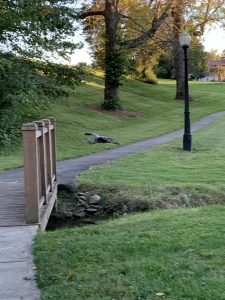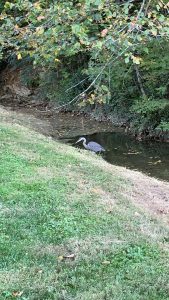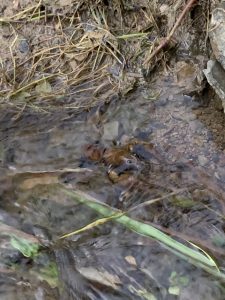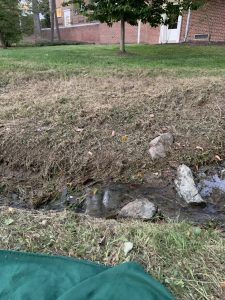October 2nd, 2020, 6:30 P.M. to 7:20 P.M., temperature around 63 degrees.
Friday was a hectic day, shadowing the previous days by a tenfold. My day consisted of running back and forth to the barn, attending a clinic, a full day of classes, and a few meetings to top it all off. By the afternoon, I needed a break and decided to go to my sit spot, relax, and enjoy the space around me and let go of the stressors of the day. I threw on a sweatshirt, grabbed a blanket, and walked down to my spot by Beale Creek.
I was halfway down the sidewalk leading to my sit spot when I was suddenly stopped by what I saw. A blue heron was standing in the water to the left of the footbridge. I stopped for a few minutes, then decided to test my luck and approach the bridge. When I was approximately 10 feet from the bridge, the heron took flight, showing off its impressive wingspan (see picture). It stuck close to the creek, however, and landed directly where I typically place my blanket for my sit spot. I stood still for a few minutes, waiting to see what would happen. Slowly and carefully, the heron walked down the creek bed and waded into the water. By this point, I had walked onto the bridge. I was hoping to witness the heron feeding but unfortunately, it was either deterred by my presence or a lack of prey. After 3 minutes, the heron had waded around the bend upstream, out of view.

 The heron in flight and wading in the creek.
The heron in flight and wading in the creek.
After my encounter with the heron, I officially started my 15 minutes of quiet observation. I worked on heightening my different senses—I could hear the calls of bluejays in the grove of trees behind me, the soothing babble of the water spilling over rocks in the creek, and the distant rumble of cars and trucks zipping past campus on Williamson Road. While focusing, I could point out when a heavy truck passed over the bridge—it created a loud, distinct rumble. I focused on what I could see, and what I found was disheartening. The riparian area surrounding the creek which had previously consisted of grasses and wildflowers had been mowed down. Now, the only remainder of plant life was closely cropped grasses. The beautiful yellow ironweed, orange touch-me-not, and blue lobelias had all disappeared.
The creek this week was experiencing rapid flow, a drastic change from the first time when the water levels were low and not flowing. Directly in front of me, I saw a group of 4 snails. They were interesting to look at but there was not enough going on to be able to write about. I continued my hunt for an invertebrate and was overjoyed when I found a crayfish. This crayfish was roughly 3 inches long from tail to claw tip, was a deep red-brown color, and appeared to have a thick exoskeleton. I peered over the creek and must have gotten too close because he immediately shot backwards and disappeared. I sat back for a few minutes and suddenly saw him reappear. I knew to hang back this time and watch as the crayfish, (named “Mr. Cray”), made a slow journey upstream. He clawed his way forward over the rocks that stood between him and higher ground. He made good progress but, unfortunately, the journey was too much for him and he suddenly lost his grip and was once more jostled downstream. I thought this was the end of Mr. Cray, but lo and behold, he reappeared again a few minutes later. He remained stationary at the base of the rocks for a few minutes. Instead of attempting to climb over the rocks again, he pulled himself out of the water onto dry land. This action surprised me as I was unaware of this possibility. Mr. Cray continued an upward trek for about a foot, leveled out his path, went around a large rock, and then proceeded down the hill and back into the water. He plopped into the deeper, slower water and was instantly gone. I knew at this point the crayfish had completed his task and would not be seen again. I puzzled on his actions for a while before determining the following: he had chosen the path of least resistance. Although being exposed on dry land made him a greater target for predators, the crayfish was physically unable to maneuver through the rapid section of the stream to get to the slower water.
 Mr. Cray pondering his next move.
Mr. Cray pondering his next move.
The role of water is important in all ecosystems, but it plays a pivotal role here. The first week I sat in this spot, I was greeted by a stream that had hardly any water and sections of thick, exposed mud and a lack of biodiversity. This time, after abundant rainfall, I witnessed a large variety of diversity I did not expect to see in this location. It is clear that life in this area is dependent on the amount of water the creek possesses at a given time. At low levels, a wide range of life cannot be supported. It will be interesting to see how the ever-changing water levels impact life in the weeks to come.
 As you can see, the grasses and flowers have been mowed, leaving the creekside brown and bleak. The water level, however, is higher than it was previously.
As you can see, the grasses and flowers have been mowed, leaving the creekside brown and bleak. The water level, however, is higher than it was previously.
Within this blog, I have included many photos, including the blue heron in flight and stationary, Mr. Cray, the water levels, and the mowed riparian area. Although I have only been in my sit spot twice, I have already encountered a wide range of biodiversity and changing environmental factors. The consistent change reinforces the idea that nothing in nature is concrete—it is all interconnected. I look forward to revisiting this spot throughout the semester and perhaps into the next to witness the changes brought forth.

That is so cool that you spotted a blue heron and even captured a pic before it took flight! What a beautiful bird, I’m so amazed.
Its amazing how many types of birds and insects you find in your sit spot!
You picked a great spot! You get to see many cool things that I didn’t think I would ever see this close to home!
LOVE the pics of the GBH – there is so much life….we just need to slow down and be present with it – good job Katie